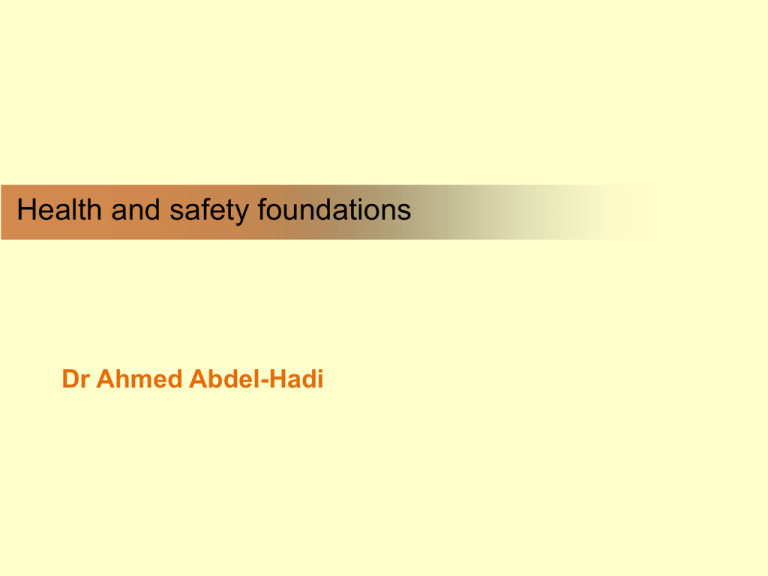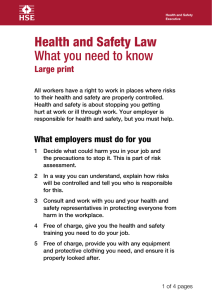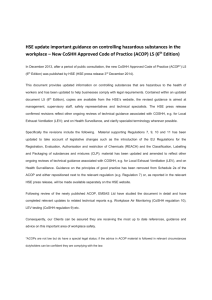Health and safety foundations Dr Ahmed Abdel-Hadi
advertisement

Health and safety foundations Dr Ahmed Abdel-Hadi Learning outcomes 1. outline the scope and nature of occupational health and safety 2. explain briefly the moral, legal and financial reasons for promoting good standards of health and safety 3. outline the legal framework for the Regulation of health and safety 4. identify the nature and key sources of health and safety information. key elements of a health and safety management system Introduction The UK Health and Safety Executive’s (HSE) mission is: To ensure that the risks to health and safety of workers are properly controlled. To encourage organizations to improve health and safety management systems to reduce injuries and ill health. To demonstrate the importance of health and safety issues at board level To report publicly on health and safety issues within their organization, including their performance against targets. The HSE believes that effective management of health and safety is : vital to employee well-being has a role to play in enhancing the reputation of businesses helping them achieve high-performance teams is financially beneficial to business. Some basic definitions Health – The protection of the bodies and minds of people from illness resulting from the materials, processes or procedures used in the workplace. Safety – The protection of people from physical injury. Welfare – The provision of facilities to maintain the health and well-being of individuals at the workplace. Welfare facilities include washing and sanitation arrangements, the provision of drinking water, heating, lighting, accommodation for clothing, seating and eating and rest rooms. Firstaid arrangements are also considered as welfare facilities. Occupational or work-related ill health – This is concerned with those illnesses or physical and mental disorders that are either caused or triggered by workplace activities. Such conditions may be induced by the particular work activity of the individual or by activities of others in the workplace. Environmental protection – These are the arrangements to cover those activities in the workplace which affect the environment and, possibly, the health and safety of employees and others. Such activities include waste and effluent disposal and atmospheric pollution. Accident – This is defined by the Health and Safety Executive (HSE) as ‘ any unplanned event that results in injury or ill health of people, or damage or loss to property, plant, materials or the environment or a loss of a business opportunity ’ . Near miss – This is any incident that could have resulted in an accident. Knowledge of near misses is very important as research has shown that, approximately, for every 10 ‘ near miss ’ events at a particular location in the workplace, a minor accident will occur. Dangerous occurrence – This is a ‘ near miss ’ which could have led to serious injury or loss of life. Dangerous occurrences are defined in the Reporting of Injuries, Diseases and Dangerous Occurrences Regulations 1995. Hazard and risk – A hazard is the potential of a substance, person, activity or process to cause harm. Hazards take many forms including, for example, chemicals, electricity and working from a ladder. A risk is the likelihood of a substance, activity or process to cause harm. A risk can be reduced and the hazard controlled by good management. The Health and Safety at Work Act 1974 (HSW Act) • The HSW Act resulted from the findings of the Robens Report, published in 1972. • Earlier legislation had tended to relate to specific industries or workplaces. • Lord Robens recommendations were as follows: There should be a single Act that covers all workers and that Act should contain general duties which should ‘ influence attitudes ’. The Act should cover all those affected by the employer’s undertaking such as contractors, visitors, students and members of the public. There should be an emphasis on health and safety management and the development of safe systems of work. This would involve the encouragement of employee participation in accident prevention. (This was developed many years later into the concept of the health and safety culture.). Enforcement should be targeted at ‘ self regulation ’ by the employer rather than reliance on prosecution in the courts. These recommendations led directly to the introduction of the HSW Act in 1974. • The Act is enforced by the Health and Safety Executive (HSE). • The prime function of the HSE remains the same To monitor, review and enforce health and safety law. to produce codes of practice and guidance. also undertakes many other activities, such as the compilations of health and safety statistics, leading national health and safety campaigns, investigations into accidents or complaints, visiting and advising employers and the production of a very useful website. • Where the Health and Safety Commission considers that the law is not functioning well, it has three main options. It can issue: • Guidance • Approved codes of practice (ACOP) • Regulations. HSC Guidance has three purposes: • Firstly to help people understand the law by interpreting it • Secondly to help people comply with the law • Thirdly to provide technical advice. • An ACOP is produced for most sets of Regulations by the HSE and attempts to give more details on the requirements of the Regulations. • A failure to observe an approved code of practice does not render a person liable to any civil or criminal proceedings. • However, a code is admissible in evidence in a criminal court, and proof of a failure to meet its requirements will be sufficient to establish a contravention of a statutory provision, unless a court is satisfied that the provision was complied with in some other way. • The HSC considers that a duty-holder who has complied with an ACOP will have done enough to satisfy the law on the specific issues addressed by the code. HSC Regulations are made under HASAWA 1974. • Regulations may be proposed by the HSE and approved by Parliament. They identify specific risks and set out particular actions that must be taken. • In practice most Regulations are made to comply with EC Directives. Every employer with five employees or more must prepare and revise a written statement of its general policy on health and safety at work, and the organisation and arrangements for carrying out that policy. The Act does not give any further indication of what the statement should contain, but advice and guidance notes, which are not legally enforceable, are available from the HSE. • As a minimum the safety policy should deal with the responsibilities of all employees, from the board of directors down to the shop floor. • The statement may be used as evidence if a prosecution is launched under section 37 HASAWA 1974. It should also deal with general safety precautions, mechanisms for dealing with special hazards, routine inspections, emergency procedures, training and arrangements for consulting the workforce.






